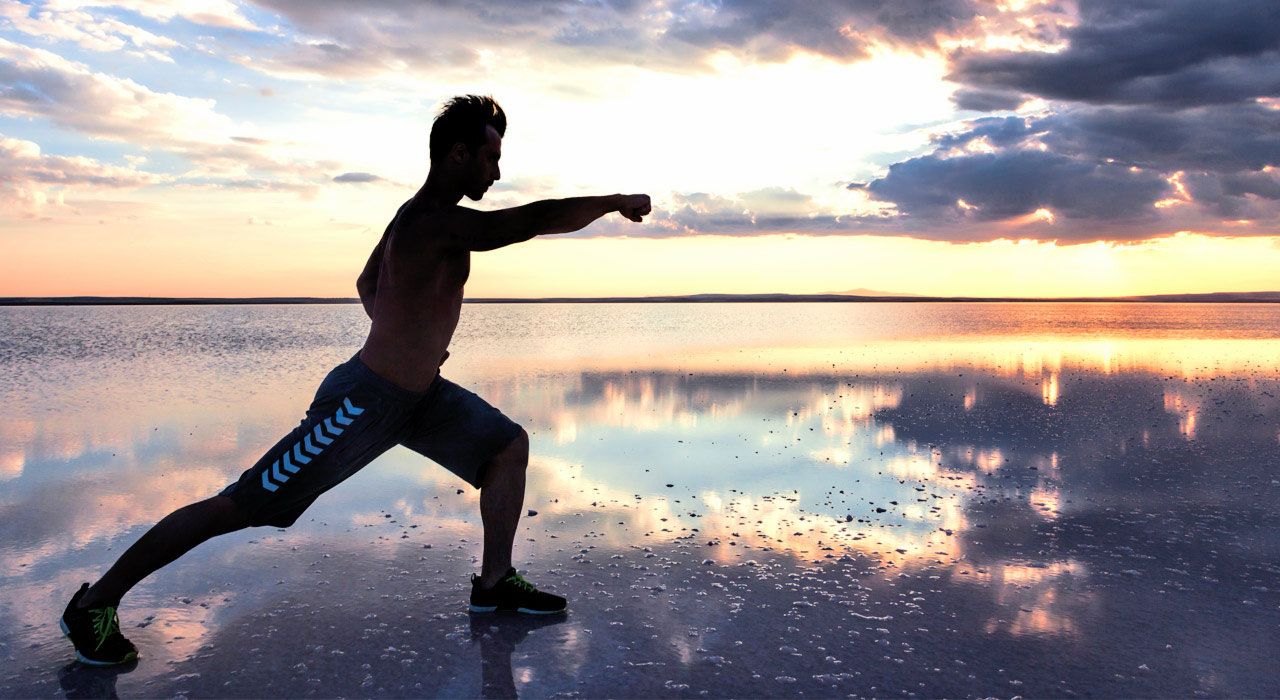Punch above your weight using the calorie-culling prowess of boxing moves with the recovery and flexibility of yoga to get, look and feel leaner by Total Boxer founder Matt Garcia and contemporary dancer Kajza Ekberg boxingyoga.com
Bulking up and burning fat, chilling and training, calm and aggression – you can’t have the best of both worlds, right? While you’re taught that it has to be one or the other or you risk failing miserably at both, there are always exceptions to the rules.
It’s precisely this notion that fused two seemingly opposing fitness disciplines to create BoxingYoga. This exercise fusion was created to explore a boxer’s strengths and weaknesses alongside those of a yogi, ultimately resulting in common ground for a new style of burning fat. It focuses on a streamlined activity, directly targeting improved sporting performance by methodically strengthening and stretching your entire body.
To complement any existing regime, this style of training offers a considered approach to explore coordination, body awareness and alignment. To maximize your performance the following routine teaches how to utilize the whole body in a kinetic chain reaction with the power of the core and spiral dynamics of the spine.
By cultivating healthy breathing habits and releasing muscular tension, it will also help to drastically shorten recovery time and prevent injuries. You can do them anywhere, in the middle of a run or on the gym floor or as a workout unto itself to improve your posture, get leaner and feel flexible.
The boxing-yoga workout
The following sequence consists of four stages: warm-up, strengthening, mobility and cool down. Perform poses 1–9 in a flow on both sides and hold each posture for three deep and calm breaths.
-
The Boxer’s Lunge II
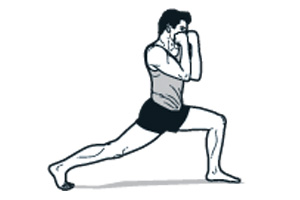
Hold a strong High Lunge, aiming for a 90-degree angle in the front leg and a straight back leg. Keep the hips parallel with an engaged core and lifted spine. Balance weight evenly between both legs, keep the chin down, and cover the jaw with the lead shoulder. Keep the wrists straight and the front knee directly above the heel.
- Why? This coordinates upper and lower body biomechanics and practice upper body boxing technique while stretching the hips, hamstrings, and psoas (the muscles that help flex the hips). The pose also strengthens the core and legs and encourages a grounded, stable stance. Participants may also use this pose to test their balance and center of gravity.
- Transition: Boxer’s Lunge II Twist
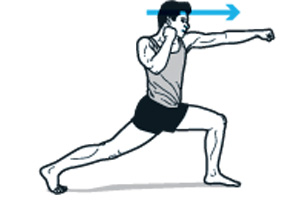
Extend the reach of the lead arm by rotating the torso slightly to the side. Aim to get the shoulders into one line. Keep the hips square and the rear heel lifted.
- Lunging Arm Circle
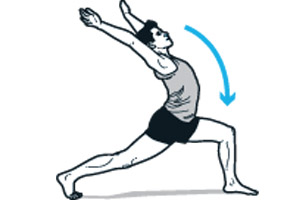
Come into strong High Lunge with feet hip-width apart. Drop the arms to the sides, inhale, and circle the arms back and up around the body. Look up at a 45-degree angle and elongate the spine while keeping a grounded stance. On an exhalation, gently clench hands into fists and draw both elbows down to a 90-degree angle or a classical “boxer’s guard.” Release any tension from the shoulders and neck, pull the elbows in close to protect the rib cage, and use fists to cover the jaw.
- Why? There are plenty of lunge variations to strengthen the legs and core and to stretch and open the hips, chest, and spine. This helps boxers develop stamina and prevent rigidity, immobility, and inflexibility. The lunges are also designed to improve coordination and balance, lowering the center of gravity and stabilizing the stance.
4. Knuckle Plank
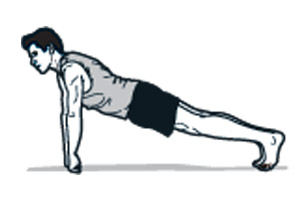
Support the body on the fists and the feet. Ensure that the thumb is placed outside the hand and tucked in. Step feet hip-width apart and bring shoulders directly above the fists. Lengthen the tailbone toward the heels and engage the core to support the lower back. Widen the shoulder blades and align the neck with the rest of the spine.
- Why? Plank strengthens the arms, core, and legs, builds shoulder stability, and develops upper-body explosiveness. Performed on the fists, Plank also strengthens the forearms and stabilizes the wrists, a fragile area for boxers that requires attention and care.
5. Transition: Low Plank
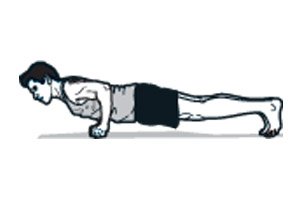
Make it more intense: Bend the elbows to hold a lower stance. Keep your body engaged and aligned body while pushing back through the heels.
6. Upward-Facing Dog Pose
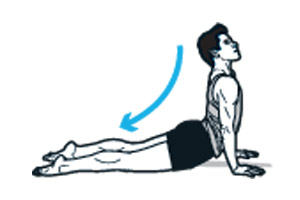
Place the hands beneath the shoulders and push up, supporting the body on the palms and feet. Keep the elbows tucked in and the shoulders and chest open. Align the neck with the rest of the spine and bring your gaze is slightly forward.
- Why? Upward-Facing Dog stretches the abdominals and hip flexors while increasing spinal flexibility. This is a great counter-stretch for boxers, who typically hold a guarded posture. Opening up the chest and shoulders, it also strengthens the core, arms, wrists, legs, and hips.
7. The Side Plank Crunch Sequence
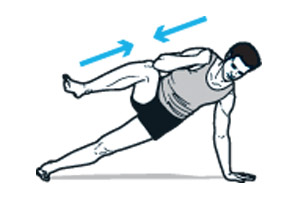
From a Side Plank, bend the raised elbow and knee to make a physical connection. Keep the spine straight and push the floor away to engage the abs and lift the hips up.
- Why? An extremely challenging set of poses, the Side Plank Sequence develops shoulder and core strength and stability. It also improves balance, control, and coordination.
8. Transition: The Side Plank Crunch Sequence
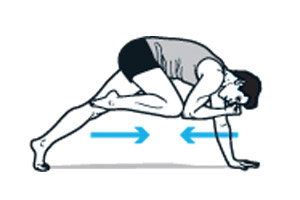
Maintaining balance, slowly rotate onto the toes and off the supporting foot until the hips and shoulders are parallel to the floor. While rotating, curl the back and crunch the abdominals. Still keeping your balance, lower the raised hand to the floor directly under the shoulder and lengthen the lifted leg. Exhale and bend the elbows slowly and through a controlled Low Plank leading into an Upward-Facing Dog. Repeat poses 1–9 on the other side.
9. Wide-Stance Forward Bend
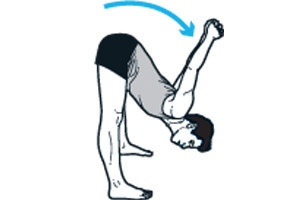
Interlock the fingers behind the back and aim to bring the palms together. Open the chest, roll the shoulders back, and engage the core. Inhale and lengthen the spine up, shift the weight onto the toes, exhale and bend forward from the crease of the hips. Maintain a straight spine and neck.
- Why? This develops flexibility in the shoulder and chest area, strengthen the core, and build body awareness for shifting weight. Boxers with a rigid lower back and hips benefit from this posture and its variations by opening and stretching the hamstrings and stabilizing the legs.
10. Threading the Needle
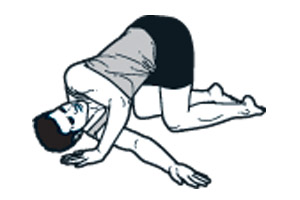
From a tabletop position, slide one arm under the torso, palm facing up. Rest the shoulder and head gently on the floor. Lift the opposite arm up perpendicular to the ground, and reach back for the crease of the hip on the opposite side. If possible, grab hold of the inside of the opposite thigh to deepen the twist in the spine and open up the chest and shoulders. Hold for 30 seconds, and repeat the stretch on the other side.
- Why? This pose offers a deep twist of the spine to increase range of movement. It also opens and stretches the chest and shoulders, which tend to be extremely tight areas for boxers.
Give this boxing yoga workout a shot for some variety in your routine and experience better fat burning, increased recovery, flexibility and fix any imbalances or weak joints on your body. A knockout combination.


